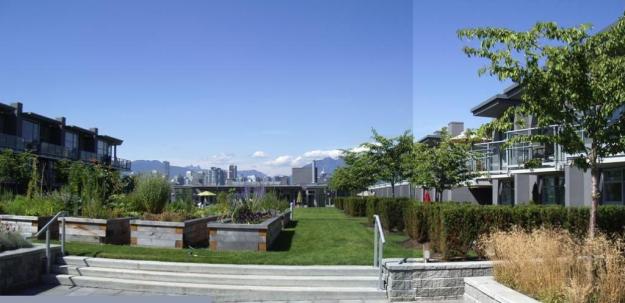 There has been an exploding interest in green roofs of late. During the recent Vision Vancouver fundraiser I was introduced to Erika Richmond who designed and built my friend Toby B.’s greenroof in the downtown east side. Walking away from the conversation I suddenly realized I may actually live on a green roof.
There has been an exploding interest in green roofs of late. During the recent Vision Vancouver fundraiser I was introduced to Erika Richmond who designed and built my friend Toby B.’s greenroof in the downtown east side. Walking away from the conversation I suddenly realized I may actually live on a green roof.
The building I live in has 4 floors of commercial real estate and a rooftop townhouse development built around a 20,000 sq ft garden and sidewalks. The “sidewalks” have ceders and trees planted along them, the main garden is a grass field and with over 14 decently sized wood garden plots.
Is it technically a green roof? I don’t know. But it does create a beautiful and relatively peaceful living space 25 meters above street in an increasingly busy part of town.
(I realize the photos do not look particularly green but you we are in the midst of what passes for winter here in Vancouver. I’ll try posting some new ones come spring/summer.)

But it turns out the beauty is the least important part of green roofs. For a policy geek like me there is a fascinating and increasing amount of research into the benefits of green roofs – some of the most interesting of which has been commissioned by the City of Toronto and available in a report it published in late 2005.
Savings to the city of Toronto, based the assumption that 100% of available green roof areas over 350 sq m. were retrofitted and that 75% of the roof area was made green, were: 
Those are some large numbers.
What an enormous opportunity green roofs would have been for the federal budget. Buildings account for a significant amount of GHG emissions and the financial savings generated by such a plan are obviously enormous. Better still the greening of the aforementioned roofs would not require the equivalent planning of say building a highway, bridge or building and so could be undertaken relatively quickly. In short, they are shovel ready. Equally important, green roofs are probably more labour intensive (as opposed to capital intensive) than many of types of infrastructure projects. This means green roof projects might be better positioned to generate jobs and help lower our rising unemployment numbers. Massive year on year savings? Significant employment? Instant initial savings? An increase in property values? Sounds like a stimulus package winner to me.
Sadly, the trend appears to be catching on more in the United States than in Canada. A cursory exploration of the web reveals that New York City recently passed a city by-law that rewards building-owners who cover 50 percent of available rooftop space with a green roof with “a one-year property tax credit of up to $100,000. The credit would be equal to $4.50 per square-foot of roof area that is planted with vegetation, or approximately 25 percent of the typical costs associated with the materials, labor, installation and design of the green roof.” Philadelphia also has a tax credit (although it appears to be little used). Chicago however is an emerging capital of green roofs with over 200!
It is unclear whether Vancouver or Toronto have such a tax credit (it didn’t appear so, but please let me know if I’m wrong). That said, a growing number of Toronto public buildings now have green roofs and Vancouver will soon be host to Canada’s largest green roof. It’s a start, but given the size of the opportunity, we could be doing so much more.



 There has been an exploding interest in
There has been an exploding interest in